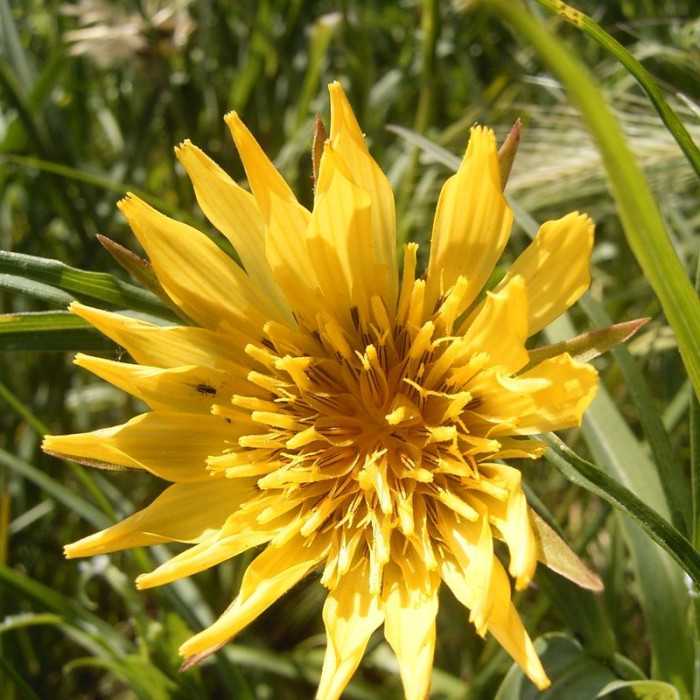Meadow salsify or Jack-go-to-bed-at-noon, showy goat's-beard or meadow goat's-beard / Tragopogon pratensis - is a biennial herbaceous, cold-resistant plant with a long taproot and a branched stem up to 120 cm high. The leaves are linear-lanceolate, sessile, amplexicaul. The flowers are light yellow, reed, in large baskets located at the end of the stem. After flowering, fluffy balls are formed, resembling faded dandelion baskets. Blooms in May-June. The plant belongs to the melliferous, blooms especially well in May.
The down of the meadow goat's beard also does not remain useless; it is used for stuffing mattresses. But the roots of the goatbeard are most valued, many use them not only for medicinal purposes, but also in cooking, they are very tasty and do not differ from other vegetables, especially if they are boiled in salt water.
Part used: Medicinal raw materials are roots, leaves, juice and flowering tops.
Collection and preparation:
The grass is harvested during flowering and air-dried under a canopy. The green part is harvested before the plant begins to bloom, the juice is extracted during the flowering period of the goatbeard. It is very important to dry all parts of the plant well in the shade in the fresh air. Then finely chop and store in a special container that closes well, preferably in a glass jar, up to 2 years, no more. Because the useful properties of the plant are lost.
Cultivation
Grows on any garden soil, including heavy, clay. A well-lit place is desirable. Easily propagated by seeds that can be sown immediately to a permanent place. The goatbeard does not require any specific care. Like any other vegetable, it needs weeding, loosening, if necessary, feeding and watering (if you see fit).
Be sure to remove the arrows from the plants of the first year - sometimes it happens that a certain number of goatbeards are preparing to bloom in the first year. If you leave flower stalks near plants and let them bloom, the root of such goatbeards will become hard and unfit for food.
The root of the goat beard is very delicate and fragile, so cleaning must be done carefully - damaged root crops are not stored at all, they quickly rot.
Useful properties of meadow goat-beard
For medicinal purposes, the root, juice, tops that bloom and leaves are used. Meadow goat's beard is an excellent diuretic, anti-inflammatory, antiseptic and wound healing agent. The stems and roots are used as a reliable way to treat and prevent scurvy.
A decoction of the root can be taken for coughs, the formation of kidney stones, liver, gastritis, stomach ulcers, skin diseases and scrofula.
If the wounds do not heal for a long time, they begin to fester, you need to use white juice from the meadow goat's beard, it perfectly relieves inflammation and heals the wound. Also, the juice is used for bedsores, a rash that itches, skin diathesis. It is good to apply fresh leaves of the meadow goat's beard to the affected skin.
The plant is popular in medicine because it contains a lot of useful active substances. The green part contains protein, fiber, fat, nitrogen-free extract, carbohydrates, which dissolve easily.
The composition of the roots includes protein, inulin, starch. The seeds contain fatty oil.
Goatbeard belongs to the medicinal species of the plant, because it has a diuretic, antiseptic and anti-inflammatory effect. Medical scientists have proven that this type of plant helps men increase their potency, because aphrodisiacs have long been using it for these purposes.
The use of the meadow goat's beard
To prepare the infusion, you need to take 2 teaspoons of the root, pour 200 ml of boiled water, leave for up to 2 hours, strain. Take one tablespoon up to 4 times a day.
The meadow goat's beard is used in collections against tumors. To inflamed wounds, swelling, pustules, ulcers, pre-shredded leaves of the plant must be attached.

No questions about this product, be the first and ask your question.












